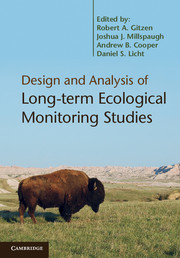Book contents
- Frontmatter
- Contents
- List of contributors
- Foreword: Ecology, management, and monitoring
- Preface
- Acknowledgments
- Abbreviations
- Section I Overview
- Section II Survey design
- 5 Spatial sampling designs for long-term ecological monitoring
- 6 Spatially balanced survey designs for natural resources
- 7 The role of monitoring design in detecting trend in long-term ecological monitoring studies
- 8 Estimating variance components and related parameters when planning long-term monitoring programs
- 9 Variance components estimation for continuous and discrete data, with emphasis on cross-classified sampling designs
- 10 Simulating future uncertainty to guide the selection of survey designs for long-term monitoring
- Section III Data analysis
- Section IV Advanced issues and applications
- Section V Conclusion
- References
- Index
- Plate Section
9 - Variance components estimation for continuous and discrete data, with emphasis on cross-classified sampling designs
Published online by Cambridge University Press: 05 July 2012
- Frontmatter
- Contents
- List of contributors
- Foreword: Ecology, management, and monitoring
- Preface
- Acknowledgments
- Abbreviations
- Section I Overview
- Section II Survey design
- 5 Spatial sampling designs for long-term ecological monitoring
- 6 Spatially balanced survey designs for natural resources
- 7 The role of monitoring design in detecting trend in long-term ecological monitoring studies
- 8 Estimating variance components and related parameters when planning long-term monitoring programs
- 9 Variance components estimation for continuous and discrete data, with emphasis on cross-classified sampling designs
- 10 Simulating future uncertainty to guide the selection of survey designs for long-term monitoring
- Section III Data analysis
- Section IV Advanced issues and applications
- Section V Conclusion
- References
- Index
- Plate Section
Summary
Introduction
Variance components may play multiple roles (cf. Cox and Solomon 2003). First, magnitudes and relative magnitudes of the variances of random factors may have important scientific and management value in their own right. For example, variation in levels of invasive vegetation among and within lakes may suggest causal agents that operate at both spatial scales – a finding that may be important for scientific and management reasons.
Second, variance components may also be of interest when they affect precision of means and covariate coefficients. For example, variation in the effect of water depth on the probability of aquatic plant presence in a study of multiple lakes may vary by lake. This variation will affect the precision of the average depth-presence association.
Third, variance component estimates may be used when designing studies, including monitoring programs. For example, to estimate the numbers of years and of samples per year required to meet long-term monitoring goals, investigators need estimates of within and among-year variances. Other chapters in this volume (Chapters 7, 8, and 10) as well as extensive external literature outline a framework for applying estimates of variance components to the design of monitoring efforts. For example, a series of papers with an ecological monitoring theme examined the relative importance of multiple sources of variation, including variation in means among sites, years, and site-years, for the purposes of temporal trend detection and estimation (Larsen et al. 2004, and references therein).
- Type
- Chapter
- Information
- Design and Analysis of Long-term Ecological Monitoring Studies , pp. 200 - 227Publisher: Cambridge University PressPrint publication year: 2012
- 18
- Cited by

